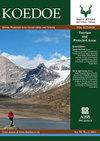南非克鲁格国家公园底栖无脊椎动物居住河流的多样性和分布
IF 1.1
4区 环境科学与生态学
Q3 BIODIVERSITY CONSERVATION
引用次数: 1
摘要
小底栖动物是一种微小的无脊椎动物,栖息在河流的生物膜和间隙中。它们种类繁多,极其丰富,通过将微生物生产与更高营养水平(如大型底栖无脊椎动物和鱼类)联系起来,发挥重要的生态功能。然而,对非洲中新生群落的研究仍然很少。在这里,我们沿着流经克鲁格国家公园(KNP)的Olifants, Sabie和鳄鱼河的上游-下游梯度取样了与生物膜和沉积物相关的小型和大型底栖无脊椎动物群落。我们希望将社区结构的差异与环境梯度联系起来,因为这些河流在进入公园时表现出不同程度的人为压力。小型底栖动物和大型底栖动物群落在河流之间存在差异,并沿上下游梯度结构。最靠近公园边界的上游地点,在所有三条河流中一致显示出较低的多样性。入侵螺Tarebia granifera在大底栖动物中占73% - 87%的优势地位,挤占了硬底栖物,同时线虫、轮虫等小底栖生物的丰度也大幅减少。然而,随着水流经公园下游,群落的多样性和均匀性趋于增加,这表明受保护的河流对底栖无脊椎动物的多样性产生了有益的影响。然而,对于构成公园南部边界的鳄鱼河来说,这种趋势不那么明显,这表明这条河可能面临最大的威胁。更一般地说,底栖无脊椎动物群落受磷酸盐、硫酸盐、铵和有机物的浓度以及底物特性的驱动。保护意义:中新生生物在西北河流中非常丰富,并对环境梯度有反应;因此,它们更应该被考虑用于生物监测或动物综合组合的保护。有趣的是,受保护的河段往往显示出入侵的花枝棘虫的优势地位降低,而底栖无脊椎动物的多样性更高。本文章由计算机程序翻译,如有差异,请以英文原文为准。
Diversity and distribution of benthic invertebrates dwelling rivers of the Kruger National Park, South Africa
Meiobenthos (or meiofauna) are microscopic invertebrates that inhabit biofilms and interstitial spaces in rivers. They are diverse and extremely abundant, and they perform essential ecological functions by linking microbial production to higher trophic levels (e.g. macrobenthic invertebrates and fishes). However, meiobenthic communities remain poorly studied in Africa. Here, we sampled meio- and macrobenthic invertebrate communities associated with biofilms and sediments across an upstream–downstream gradient along the Olifants, Sabie and Crocodile rivers flowing through the Kruger National Park (KNP). We expected to link differences in community structure to environmental gradients as those rivers show different degrees of anthropogenic stress as they enter the park. Both meio- and macrobenthic communities differed across rivers and also structured along an upstream–downstream gradient. The upstream sites, which were the closest to the park borders, consistently showed a lower diversity in all three rivers. There, the invasive snail Tarebia granifera strongly dominated (making up 73% – 87% of the macrobenthos), crowding hard substrates, while concomitantly the abundances of biofilm-dwelling meiobenthos like nematodes and rotifers were substantially reduced. Nevertheless, the diversity and evenness of communities then tended to increase as water flowed downstream through the park, suggesting a beneficial effect of protected river reaches on benthic invertebrate diversity. However, for the Crocodile River, which makes up the southern border of the park, this trend was less conspicuous, suggesting that this river may experience the greatest threats. More generally, benthic invertebrate communities were driven by the concentrations of phosphates, sulphates, ammonium and organic matter and by substrate characteristics.Conservation implications: Meiobenthic organisms are very abundant in KNP rivers and react to environmental gradients; thus, they should be more considered for bio-monitoring or conservation of comprehensive assemblages of animals. Interestingly, protected reaches tended to show a reduced dominance of the invasive T. granifera and a higher diversity of benthic invertebrates.
求助全文
通过发布文献求助,成功后即可免费获取论文全文。
去求助
来源期刊

Koedoe
BIODIVERSITY CONSERVATION-
CiteScore
3.30
自引率
0.00%
发文量
10
审稿时长
20 weeks
期刊介绍:
Koedoe, with the subtitle ''African Protected Area Conservation and Science'', promotes and contributes to the scientific (biological) and environmental (ecological and biodiversity) conservation practices of Africa by defining the key disciplines that will ensure the existence of a wide variety of plant and animal species in their natural environments (biological diversity) in Africa.
 求助内容:
求助内容: 应助结果提醒方式:
应助结果提醒方式:


